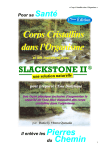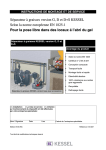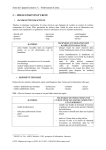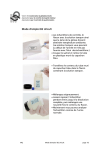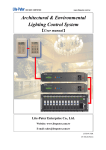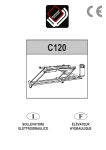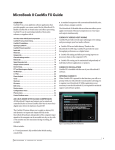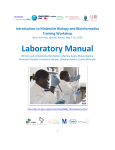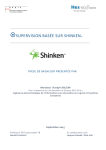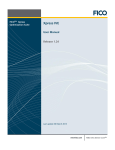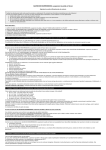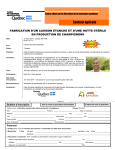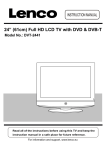Download 1 x 103 CFU/mL 1 x 104 CFU/mL 1
Transcript
1 x 103 CFU/mL 1 x 104 CFU/mL 1 x 105 CFU/mL 1 x 106 CFU/L 10 x 106 CFU/L 100 x 106 CFU/L DIP N COUNT® DIP SLIDE FOR THE DETECTION OF URINARY TRACT INFECTION Dip N Count® dip slide is a semi-quantitative culture test for the detection of URINARY TRACT INFECTION. Product Code B30U0 Media Combination MacConkey with Crystal Violet/ C.L.E.D. DESCRIPTION OF CULTURE MEDIA USED MacConkey/Crystal Violet A selective and differential medium which supports growth of gram negative bacteria and inhibits that of most gram positive bacteria. CYSTINE LACTOSE ELECTROLYTE DEFICIENT (C.L.E.D.) AGAR The medium was first described by MacKey and Sandys specifically for use in dip inoculum procedures for urinary bacteriology. The electrolyte deficient nature of the medium prevents the characteristic swarming of Proteus. Inclusion of lactose allows differentiation of lactose fermenting bacteria by changing the colour of the medium from pale green to yellow. APPROXIMATE INGREDIENTS PER LITER OF MEDIUM MacConkey Agar Pancreatic digest of gelation Pancreatic digest of casein Peptic digest of animal tissue Lactose Bile Salts Mixture Sodium Chloride Agar Neutral Red Crystal Violet 17g 1.5g 1.5g 10g 1.5g 5g 13.5g 0.03g 0.001g C.L.E.D. Agar Beef Extract Pancreatic digest of casein Pancreatic digest of gelatin L-Cystine Lactose Agar Bromothymol Blue 3g 4g 4g 0.128g 10g 15g 0.02g DIRECTIONS FOR USE 1. Collect a clean catch midstream specimen of a first morning urine in a sterile container. 2. Unscrew cap of dip slide unit and remove paddle from the vial, taking care not to touch the agar. 3. Immerse the paddle in the urine, making sure that the media are totally wetted. Never pour urine into the DIP N COUNT* container. 4. Remove the paddle from the urine. Allow the excess urine to drain from the paddle by touching the end of the slide against the wall of the vial. 5. Return the paddle to the container, close tightly and complete the patient label. 6. incubate the inoculated dip slide in an upright position at 35ºC. for 18-24 hours. 7. Compare the number of colonies visible on the paddle with the COLONY DENSITY CHART and determine the number of bacteria present per volume of urine. INTERPRETATION OF RESULTS Refer to colour chart for aid in presumptive identification. Additional biochemical tests are necessary for definitive identification. • Less than 104 CFU/mL (10 x 106 CFU/L) usually indicates an absence ofinf ection. An exception is urine obtained by catheterization or puncture, in which case less than 104 CFU/mL (10 x 106 CFU/L) may indicate the presence of infection. • 104 to 105 CFU/mL (10 x 106 to 100 x 106 CFU/L) is considered to be borderline case and it is recommended that in this case the test be repeated, since chronic and relapsing infections may give rise to counts of this order. • More than 105 CFU/mL (100 x 106 CFU/L) indicates an infection. Identification tests should be performed. NOTE When the bacterial count is high, the surfaces are covered by a confluent growth which may be over-looked. Consequently, it is recommended that all surfaces should be examined against reflected light. The lack of reflection indicates a confluent growth. This also will enable detection of small colonies. When the colony count on the two media is different, the higher count should be considered. LIMITATION OF PROCEDURE If the patient is under antibiotic treatment, the test may show a lower count than the actual condition. Therefore, dip slide tests for urinary tract infection should only be done at lease 48 hours after cessation of antibiotic administration. However, if the test reveals a significant growth of bacteria during a course of antibiotic treatment this would indicate that the antimicrobial treatment is not effective against the organisms in the urine. Follow up treatment by physician may be required. QUALITY ASSURANCE Each lot of DIP N COUNT® product is tested, where applicable according to “Quality Assurance for Commercially Prepared Microbiological Culture Media”, recommended by CLSI. The same guideline can be consulted if users decide to perform their own quality check on the product. STORAGE DIP N COUNT® units should be stored at 4º - 25ºC. for optimum shelf life. Avoid freezing and strong light. Rotate stocks. Check dating. PRECAUTIONS Do not use if media are contaminated. Do not use after expiry date. Do not touch surfaces of dip slide. If this occurs discard the unit. Bacterial growth on inoculated DIP N COUNT® dip slides are potential pathogenic microorganisms. These paddles should not be touched or exposed to personnel. DISPOSAL Disposal of inoculated dip slides should comply with state and local laws. To aid proper disposal of inoculated DIP N COUNT® paddles, it is advised that these dip slides be completely immersed in bacterial solution. Dip slides should be properly disposed of in a biohazard bag. A colour chart containing full product information is available from your dealer of Starplex Scientific Inc. REFERENCES 1. CUMITECH: Laboratory Diagnosis of Urinary Tract Infection:2009 2. Manual of Clinical Microbiology: 8th edition 3. Detection of Bacteriuria by Dip-Slide, Routine Use in Large General Hospital. American Journal of Clinical Pathology, Vol. 63, No. 4. April, 1975. 4. Product Catalog for Microbiology. Difco Laboratories. 1995. 5. Uricult, Medical Technology Corporation, Somerset, NJ. 1992. 6. Cohn, E.B., Schaeffer, A.J. Urinary Tract Infections in Adults. Digital Urology Journal. http://www.duj.com/Article/Schaeffer/Schaeffer.html 7. Clinical Microbiology Topics - Urinary Tract Infections (UTI). Clinical Microbiology. http://www.lf3.cuni.cz/ustavy/mikrobiologie/UTI.htm 8. Ronald, A.R., Alfa, M.j. Microbiology of Genitourinary System. Medmicro, Chapter 97 http://gsbs.utmb.edu/microbook/ch097.htm Manufactured by: Etobicoke, Ontario M9W 6Y3 Canada January, 2014 02141-4 1 x 103 UFC/mL 1 x 104 UFC/mL 1 x 105 UFC/mL 1 x 106 UFC/L 10 x 106 UFC/L 100 x 106 UFC/L LAME À IMMERSION DIP N COUNTTM POUR LA DÉTECTION DES INFECTIONS DES VOIES URINAIRES La lame à immersion Dip N CountMD est un test de culture semi-quantitatif pour la détection des INFECTIONS DES VOIES URINAIRES. Code du produit B30U0 Combinaison de milieux Gélose MacConkey/Complexe Violet Iodé / LCDE (C.L.E.D.) DESCRIPTION DES MILIEUX DE CULTURE UTILISÉS GÉLOSE MacConkey/Complexe Violet Iodé Un milieu de différenciation sélectif favorable à la croissance des bactéries Gram négatif et inhibiteur de la plupart des bactéries Gram positif. GÉLOSE AU LACTOSE CYSTINIQUE À DÉFICIENCE ÉLECTROLYTE (LCDE - C.L.E.D.) Ce milieu a d’abord été décrit par MacKey et Sandys spécifiquement pour utilisation dans les procédures d’inoculum immergé pour la bactériologie urinaire. La déficience électrolyte naturelle au milieu empêche l’essaimage caractéristique des Proteus. L’incorporation de lactose permet la différenciation des bactéries de fermentation du lactose en changeant la couleur du milieu de vert pâle à jaune. QUANTITÉS APPROXIMATIVES D’INGRÉDIENTS PAR LITRE DE MILIEU Gélose MacConkey Digest pancréatique de gélification Digest pancréatique de caséine Digest peptique de tissus animaux Lactose Mélange de sels biliaires Chlorure de sodium Gélose Rouge neutre Complexe violet iodé 17 g 1,5 g 1,5 g 10 g 1,5 g 5g 13,5 g 0,03 g 0,001 g Gélose LCDE (C.L.E.D.) Extrait de bœuf Digest pancréatique de caséine Digest pancréatique de gélification L-cystinique Lactose Gélose Bleu de bromothymol 3g 4g 4g 0,128 g 10 g 15 g 0,02 g MODE D’EMPLOI 1. Prélever dans un contenant stérillsé un spécimen non souillé de la première urine du matin par la méthode du mi-jet. 2. Dévisser le couvercle de l’unité da lame à immersion et retirer la plaquette du flacon en prenant soin de ne pas toucher la gélose. 3. Immerger la plaquette dans l’urine en s’assurant que le milieu est entièrement mouillé. Ne jamais verser l’urine dans le contenant DIP N COUNTMD. 4. Retirer la plaquette de l’urine. Laisser l’excédent d’urine s’égoutter de la plaquette en faisant reposer l’extrémite de la lame sur la paroi du flacon. 5. Remettre la plaquette dans le contenant, fermer hermétiquement et compléter l’étiquette du patient. 6. Incuber la lame à immersion inoculée en position verticale à 35ºC pendant 18 à 24 heures. 7. Comparer le nombre de colonies visibles sur la plaquette avec le TABLEAU DE DENSITÉ DES COLONIES et déterminer le nombre de bactéries présentes par ml d’urine. INTERPRÉTATION DES RÉSULTATS • • • • Se reporter au tableau en couleurs pour aider à l’identification de présomption. Des tests biochimiques supplémentaires sont nécessaires pour arriver à une identification définitive. Un compte de moins de 104 UFC/mL (10 x 106 UFC/L) indique habituellement l’absence d’infection. L’urine obtenue par cathéter ou par ponction fait exception et un compte de 104 UFC/mL (10 x 104 UFC/L) peut dans ces cas indiquer la présence d’une infection. Un compte de 104 à 105 UFC/mL (10 x 106 à 100 x 104 UFC/L) est considéré comme un cas-limite et il est conseillé dans cette situation de reprendre le test puisque les infections chroniques et récurrentes peuvent produire des comptes de cette magnitude. . Un compte de plus de 105 UFC/mL (100 x 106 UFC/L) révèle une infection. Des tests d’identification doivent être menés NOTA Lorsque le compte bactérien est élevé, les surfaces sont couvertes d’une croissance confluante qui peut ne pas être décelée. Il est conseillé par conséquent d’examiner toutes les surfaces devant une lumière réfléchie. L’absence de réflexion indique une croissance confluante. Cela permettra également de déceler les petites colonies. Lorsque les comptes des colonies des coonies des deux milieux diffèrent, le compte le plus élevé devrait être retenu. LIMITATION DE LA PROCÉDURE Si le patient est sous traitement antibiotique, le test pourra indiquer un compte moins élevé que son état réel. Les tests de lame à immersion pour le dépistage des infections des voies urinaires devraient donc seulement être effectués au moins 48 heures après l’arrêt de l’administration d’antibiotiques. Si cependant le test indique une croissance importante des bactéries alors qu’un traitement antibiotique est en cours, cela indique que le traitement antimicrobien n’est pas efficace contre les organismes présents dans l’urine. Il pourra être nécessaire qu’un médecin assure un traitement de suivi. ASSURANCE DE QUALITÉ Chaque lot de produits DIP N COUNTMD fait l’objet de tests là où c’est la norme conformément à l’ « Assurance de qualité pour les milieux de culture microbiologique préparés commercialement » (Quality Assurance for Commercially Prepared Microbiological Culture Media) préconisée par la CLSI. Les utilisateurs désireux de procéder à leur propre analyse de qualité du produit peuvent consulter cette directive. CONSERVATION Les unités DIP N COUNTMD doivent être entreposées à une température de 4 à 25ºC pour une durée de conservation optimale. Éviter la congélation et une forte lumière. Procéder à une rotation des stocks. Vérifier les dates. PRÉCAUTIONS Ne pas utiliser si le milieu ou contaminé. Ne pas utiliser après la date de péremption. Ne pas toucher aux surfaces de la lame à immersion. Jeter l’unité les cas échéant. La croissance bactérienne apparaissant sur les plaquettes DIP N COUNTMD inoculées est constituée de micro-organismes potentiellement pathogènes. Ces plaquettes ne deivent pas être touchées et le personnel ne doit pas y être exposé. ÉLIMINATION L’élimination des lames à immersion inoculées doit se faire conformément aux lois étatiques et locales. Pour contribuer à l’élimination adéquate des plaquettes DIP N COUNTMD inoculées, il est conseillé d’immerger entièrement les plaquettes dans une solution bactéricide. Les lames à immersion doivent être adéquatement éliminées dans des sacs des mise au rebut biologique. Un tableau en couleurs comportant tous les renseignements sur le produit est disponible chez votre détaillant et chez Starplex Scientific Inc. RÉFÉRENCES 1. CUMITECH: Laboratory Diagnosis of Urinary Tract Infection:2009 2. Manual of Clinical Microbiology: 8th edition 3. Detection of Bacteriuria by Dip-Slide, Routine Use in Large General Hospital. American Journal of Clinical Pathology, vol. 63, Nº 4, avril 1975. 4. Product Catalog for Microbiology. Difco Laboratories. 1995. 5. Uricult, Medical Technology Corporation, Somerset, NJ. 1992. 6. Cohn, E.B., Schaeffer, A.J. Urinary Tract Infections in Adults. Digital Urology Journal. http://www.duj.com/Article/Schaeffer/Schaeffer.html 7. Clinical Microbiology Topics - Urinary Tract Infections (UTI). Clinical Microbiology. http://www.lf3.cuni.cz/ustavy/mikrobiologie/UTI.htm 8. Ronald, A.R., Alfa, M.j. Microbiology of Genitourinary System. Medmicro, chapitre 97. http://gsbs.utmb.edu/microbook/ch097.htm Fabriqué par: Etobicoke, Ontario M9W 6Y3 Canada 02141-4




